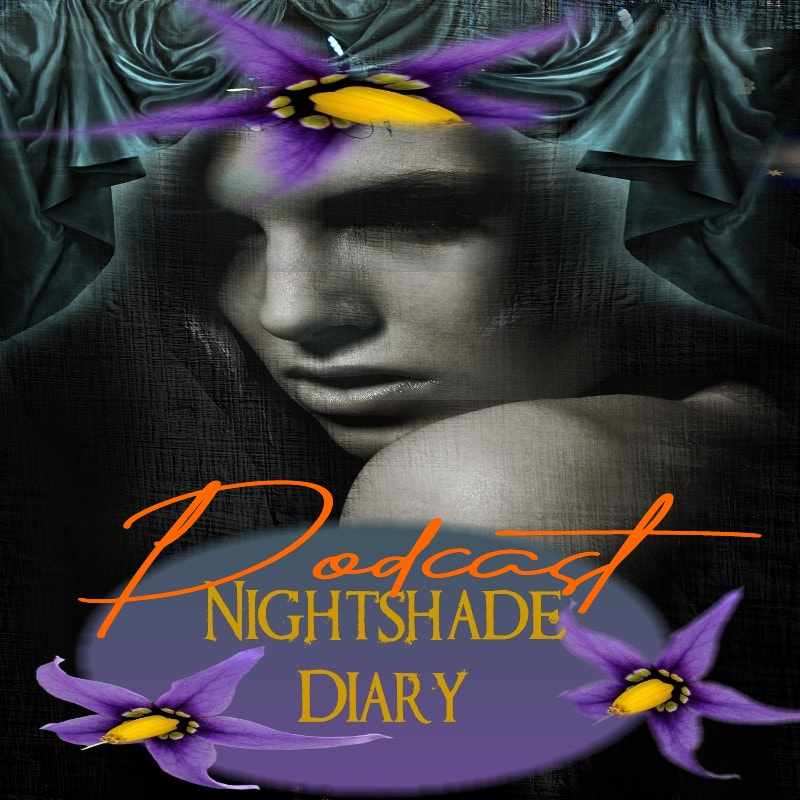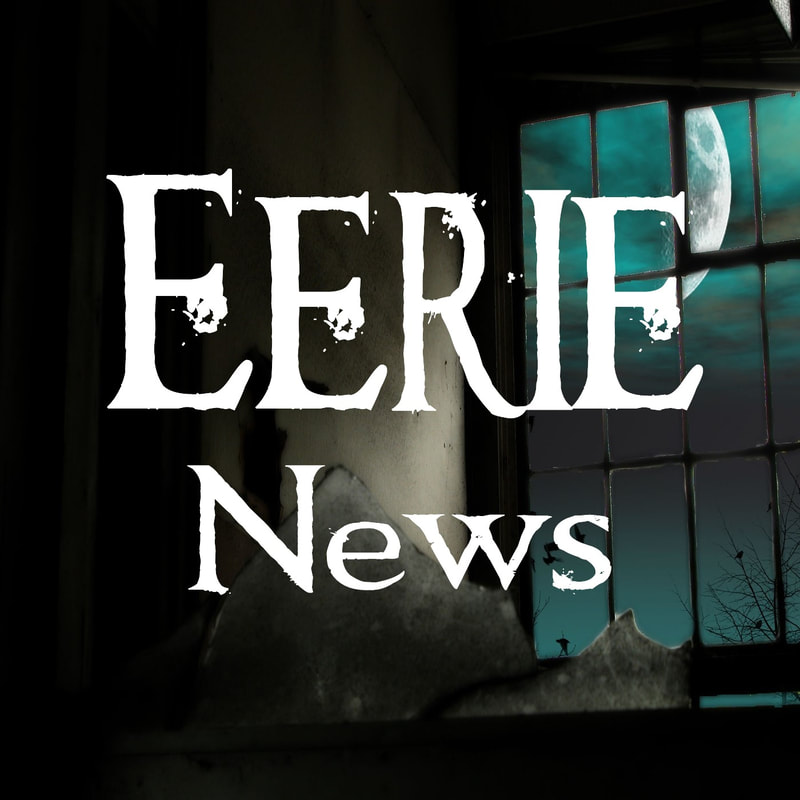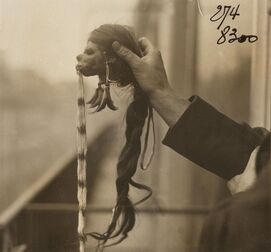 By M.P. Pellicer | Stranger Than Fiction Stories In the early 1900s, shrunken heads known as tsantsas were acquired at U.S. museums. Despite being macabre they fascinated the public. 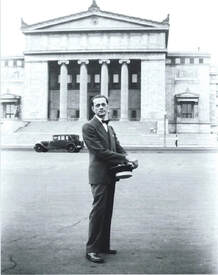 Gustave Struve in Chicago c.1933 (Source - Gertrude Ruble Struve) Gustave Struve in Chicago c.1933 (Source - Gertrude Ruble Struve) During the early 20th century, travelogues of life in the darkest jungles of the Amazon were written by Lewis Cotlow and Robert Ripley of Ripley's Believe it or Not fame. In 1940, Gustav Struve a native of Ecuador of German descent, made the rounds of the speaking circuit with a presentation titled My Four Years with the Head Hunters of the Amazon. His story placed him as the only survivor of an "ill-fated botanical expedition". It seems he was spared, and married the chief's daughter. During his years among the headhunting tribe he learned the "secret process of shrinking human heads and even entire bodies." He finally made an escape with their child. Prior to this he had attended university in Guayaquil, and went on to marry an Ecuadoran woman. They had a son. During the early 1920s, he traveled throughout south and central America conducting business. This lifestyle brought about a permanent separation from his wife. He immigrated to Chicago in 1925, and worked for the Argentine consulate. He married his second wife, Gertrude in 1939.  Jivaro Indian Witch Doctor with Shrunken Head Jivaro Indian Witch Doctor with Shrunken Head Research into Struve's expedition where he was supposedly taken prisoner by Amazonian natives could not be substantiated, and his references were vague. Supposedly it was a botanical journey initiated in 1914. However, among Struve's papers there was newspaper clippings of a talk given by Herbert Huth, a German engineer who detailed the exact experiences Struve described. Huth claimed he was taken captive by cannibals near the headwaters of the Amazon during the 1920s. He also learned the secrets of shrinking heads and bodies. It's believed Struve used the story as the inspiration for his lectures, during a time when adventure stories thrived. Fritz W. Up de Graff wrote a book in 1923, where he wrote of a man in Panama who "makes a business of preparing and shrinking heads, and who has even shrunken two entire bodies, one of an adult, the other evidently a child". Struve by his own admission lived in Panama during 1923. Was he shrinking human heads there as well? Beside speaking about his adventures Struve sold "Jivaro" shrunken head trophies. He sold one in 1933 to the Adventurers Club for $52. One of the shrunken men was sold to New York City’s Museum of the American Indian (MAI), which came with a price tag of $500, which in 1923 was a significant amount of money.  Illustration and photo from Carl Lester Liddle's story c.1926 (Source - Oakland Tribune) Illustration and photo from Carl Lester Liddle's story c.1926 (Source - Oakland Tribune) Due to the demand for shrunken heads, producing counterfeit ones became a cottage industry. They were not produced by the Jivaro tribes, but mostly by individuals who used the bodies of unclaimed paupers to fill the demands from the tourists. M.W. Stirling an ethnographer wrote in 1938, that he believed the counterfeit shrunken heads were being produced as far back as 1872 in different places in Panama, Colombia and Ecuador by a "white man living on the border of the Jivaro country". He had learned the process from the natives between the late 1800s to the the early 1900s. Fake tsantas were differentiated by having facial hair since the Jivaro would singe any hair off. Vine was used to close the lips versus string, and they didn't have holes in the skull which would enable a warrior to hang it around his neck during ceremonies.  Argentinians with shrunken heads c.1930s Argentinians with shrunken heads c.1930s The Jivaro tribes believed that killing a man created an avenging soul that would leave the corpse via the mouth and come after the pertrator, which is the reason the lips were sewn shut. True ceremonial tsantsas would have charcoal rubbed over it to prevent the spirit from "seeing" out. In the 2002 book, Shrunk Heads: Tsantsa Trophies and Human Exotica it was found that only 23 of 125 museum and privately collected heads are authentic. Whether the curator knew at the time of the sale is unknown. The motivation to buy it anyway was there, since the shrunken heads were sure to draw audiences when they were displayed. In 1926, Carl Lester Liddle (1897-1968) an American journalist and collector, described seeing a shrunken head the first time being displayed in the window of a big New York Store. It was about the "size of an orange, black and shiny, with strongly marked little features and long, coarse, black hair." A placard underneath it explained it was produced by the Shuara Indians in Ecuador. He decided to travel to South America to discover how they were produced. He was in Argentina, and the day before he was set to leave into the jungles, a veteran American traveler who was an old friend told him he was a fool. He said: Do you realize, that you'll be the first white man most of those Indians have ever laid eyes on —one of the few whites that have ever been donkey enough to risk it? Brown heads with long black hair are familiar to those devils. But think what they'd do to get hold of a white head! You'll be a curiosity for once in your life. If you go in, some Indian will come to me a year or so from now to get a thousand dollars out of me for a rare white head—nothing like it has been seen before. And, my friend, that head will be your head. Don't go into the Oriente of Ecuador. It's sheer craziness.  Jivaro head hunters during a ritual. Appeared in book Amazon Head Hunters by Lewis Cotlow Jivaro head hunters during a ritual. Appeared in book Amazon Head Hunters by Lewis Cotlow Despite the advice, he left to what was called the "Land of the Head Hunters", "Land of the Phantom Hunters" and "Land of Women Man-Hunters." This area included part of Ecuador and part of Peru. He traveled two weeks reaching the Andean heights until arriving in the jungle where the Shuara lived. The first village they reached was the Arepicos, which was made up of 15 or 20 huts with thatched roofs. Based on information he garnered along the way, he decided to pose as a "white capitu" or witchdoctor. He also grew his beard out. He knew he had to be careful not to incur any revenge from the natives, where revenge was a cult. He spent 3 days there, and was warned not to cross an invisible line that divided where the men slept and where the harem slept. The guide told him his last client ended up getting his head chopped off, since the natives were very jealous. 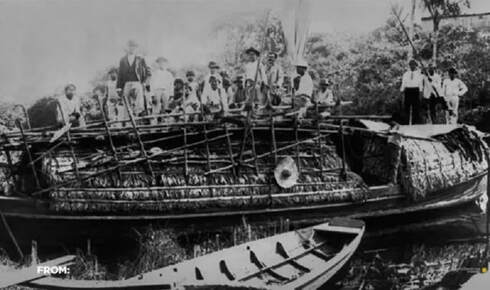 Expeditions into South America and the Amazon c.1920s-1930s Expeditions into South America and the Amazon c.1920s-1930s Before he left the chief took him to a room where he kept 11 heads. The mouths were sewn with red cord in order to "keep the spirits submissive". The Shuara native explained that he had acquired the trophies by wiping out the males of an entire family who were blood-fueled enemies. The man laid a finger on one of the heads, and with gleaming eyes explained, "This one was once on the shoulder of a mighty man, who had the wickedness to steal one of my wives. He and his brothers and his sons, we made their heads small." He traveled further into the interior staying with different Shuara villagers. One day he spent the night with his guides in the hut of a half-breed trader. Early one morning as they were about to leave, he saw one of the guides dipping the tip of his lance into a gourd of poison that always hung over his shoulder. For a moment he was not sure who the guide meant to kill. Suddenly the man plunged his lance into the half-breed's chest and then vanished into the jungle. He reached for his rifle when his main guide Juanga held him back. He said, "Put down the rifle... it is a custom with the headhunters that they enjoy killing someone at the break of day. It brings good luck for the rest of the trip." The "murderous" guide eventually rejoined the party. Unexpectedly they stumbled on a war party made up of 80 warriors. They were excited and dancing. On a banana leaf lay a collection of severed enemy heads. He saw where each head received a vertical blow at the back with a machete. He didn't describe the rest of what he called "gruesome" details, only saying the tsantsa was fitted over a wood ball about the size of an orange. During the ritual the men yelled and the wives sang, which was to render harmless the spirit of the enemy. When the head was dry it was rubbed with a liquid to make the skin hard. The wooden ball was removed from the slit in the back of the head, which was then sewed up. The victory feasts could last from six months to a year and even two years. Guests would come by the hundreds and spend a week.  Jivaro shrunken head c.1930 Jivaro shrunken head c.1930 He ran into a problem when he tried to take a lock of hair from one of the women. A witch doctor warned that witchcraft on a woman, where she was prayed to death, could be done if her hair was taken. Much of the ceremony was done to make sure the victim did not inflict revenge on the slayer. He spent a year traveling through headhunter territory. He went on to describe that secret traffic existed for the heads where tourists in Ecuador had paid as high as $500 for one of them. Ecuador passed a law, which made it a crime to sell or buy the shrunken heads, and tourists could not take them through customs, however a bootlegging operation sprung up to meet the demand. In 1928, Don Mario Ramirez de Velazco of Buenos Aires brought a collection of historic Spanish and Inca antique art to Los Angeles. Among the pieces, "of intrinsic value because of their rarity might also be mentioned a collection of shrunken and mummified heads, an art known only to three tribes of Ecuador Indians, the Tsantsas, the Jibaros and the Macabeos."  Shrunken head owned by a museum which turned out to belong to a woman Shrunken head owned by a museum which turned out to belong to a woman In the mid 1940s the Jivaro tribes learned that shrunken heads could be traded for a shotgun. Shuar warriors would take the heads of whole families belonging to the Achuar tribes. They did this for two reasons, one was the commerce aspect, the other was since the Achuar were reduced to using spears they were easier to capture. They would refer to the Achuar as fish—as in, “Let’s go catch some fish.” By 1998, the Achuar had the world’s second-highest murder rate. According to anthropologist John Patton, who studied intratribal murder and revenge in the Conambo River Valley, observed Achuar men would not "so much as go out for a piss without bringing a rifle". In 2016, a museum did a DNA analysis of a shrunken head they had. The curators were told it belonged to a male shaman who had failed to cure a child, and was killed by the father. The analysis revealed the head belonged to a woman. This disputed the Shuar society reasoning for taking a head, which was to stop the soul of the warrior from taking revenge. Shuar women were never warriors. The reason why she was used is unknown, but most probably it was for commercial purposes. It's not even known if she was a native, she could have just been a body that ended up unclaimed in the morgue.
0 Comments
Your comment will be posted after it is approved.
Leave a Reply. |
Stranger Than Fiction StoriesM.P. PellicerAuthor, Narrator and Producer Archives
July 2024
Categories
All
|
Stories of the Supernatural
- Stories of the Supernatural
- Miami Ghost Chronicles
- M.P. Pellicer | Author
- Stranger Than Fiction Stories
- Eerie News
- Supernatural Storytime
-
Astrology Today
- Tarot
- Horoscope
- Zodiac
-
Haunted Places
- Animal Hauntings
- Belleview Biltmore Hotel
- Bobby Mackey's Honky Tonk
- Brookdale Lodge
- Chacachacare Island
- Coral Castle
- Drayton Hall Plantation
- Jonathan Dickinson State Park
- Kreischer Mansion
- Miami Biltmore Hotel
- Miami Forgotten Properties
- Myrtles Plantation
- Pinewood Cemetery
- Rolling Hills Asylum
- St. Ann's Retreat
- Stranahan Cromartie House
- The Devil Tree
- Trans-Allegheny Lunatic Asylum
- West Virginia Penitentiary
- Paranormal Podcasts
"When misguided public opinion honors what is despicable and despises what is honorable, punishes virtue and rewards vice, encourages what is harmful and discourages what is useful, applauds falsehood and smothers truth under indifference or insult, a nation turns its back on progress and can be restored only by the terrible lessons of catastrophe."
- Frederic Bastiat
- Frederic Bastiat

Copyright © 2009-2024 Eleventh Hour LLC. All Rights Reserved ®
DISCLAIMER
DISCLAIMER
 RSS Feed
RSS Feed


